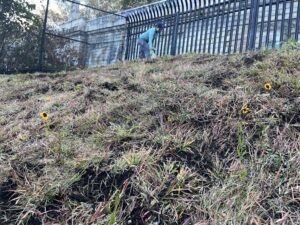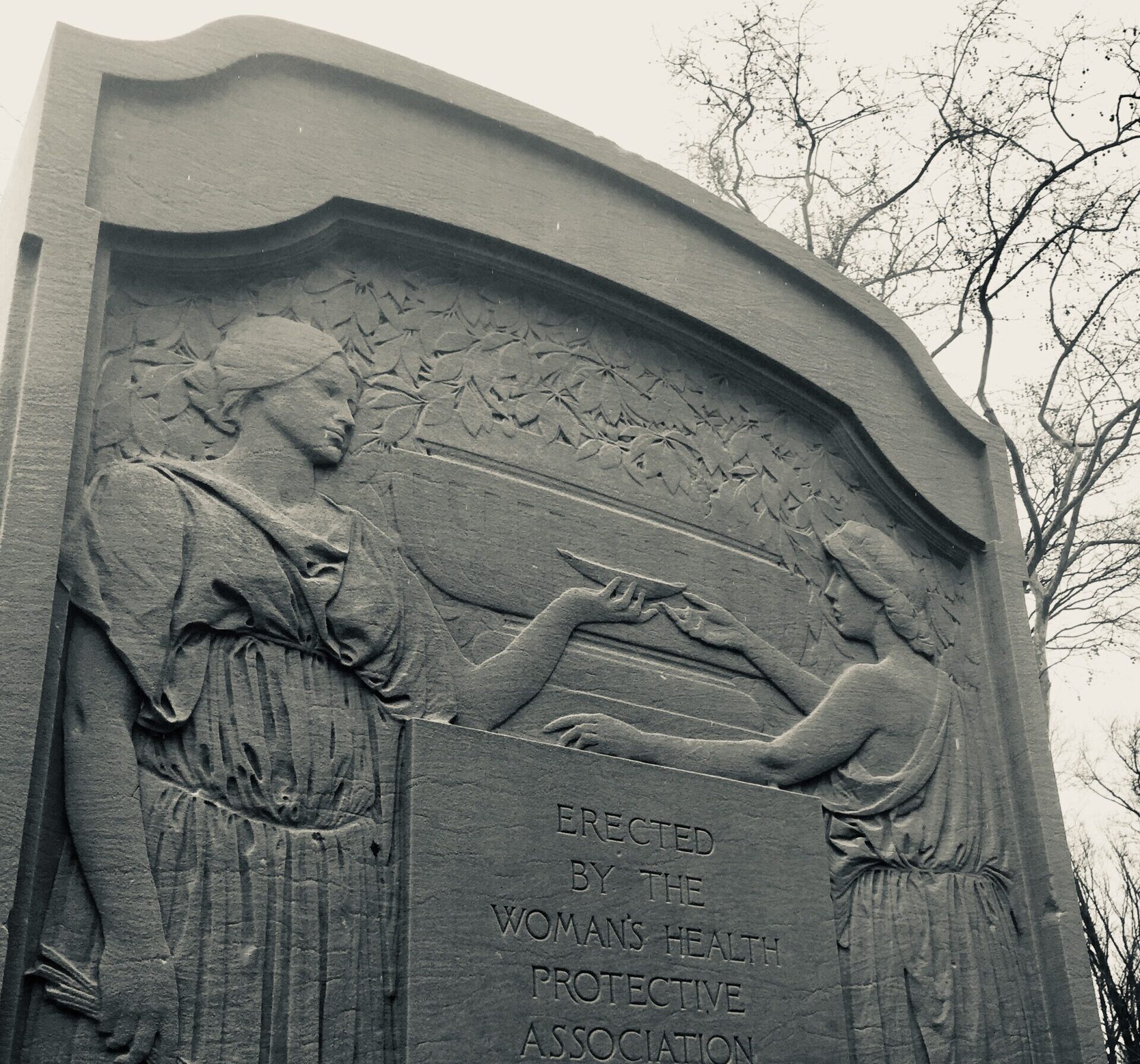by Nina Webb, Field Supervisor
I moved to the Upper West Side in 1989, and I’ve been working in Riverside Park – first as a volunteer and then as a member of the Riverside Park Conservancy horticulture staff – for over twenty years. As a history buff, I’ve loved learning about the history of Riverside Park as well as its many plaques, statues and monuments. I am especially proud of the monuments that have been made for women, often by women artists. In honor of Women’s History Month, I am happy to have the opportunity to be able to share them with you.
Joan of Arc Statue
West 93rd Street
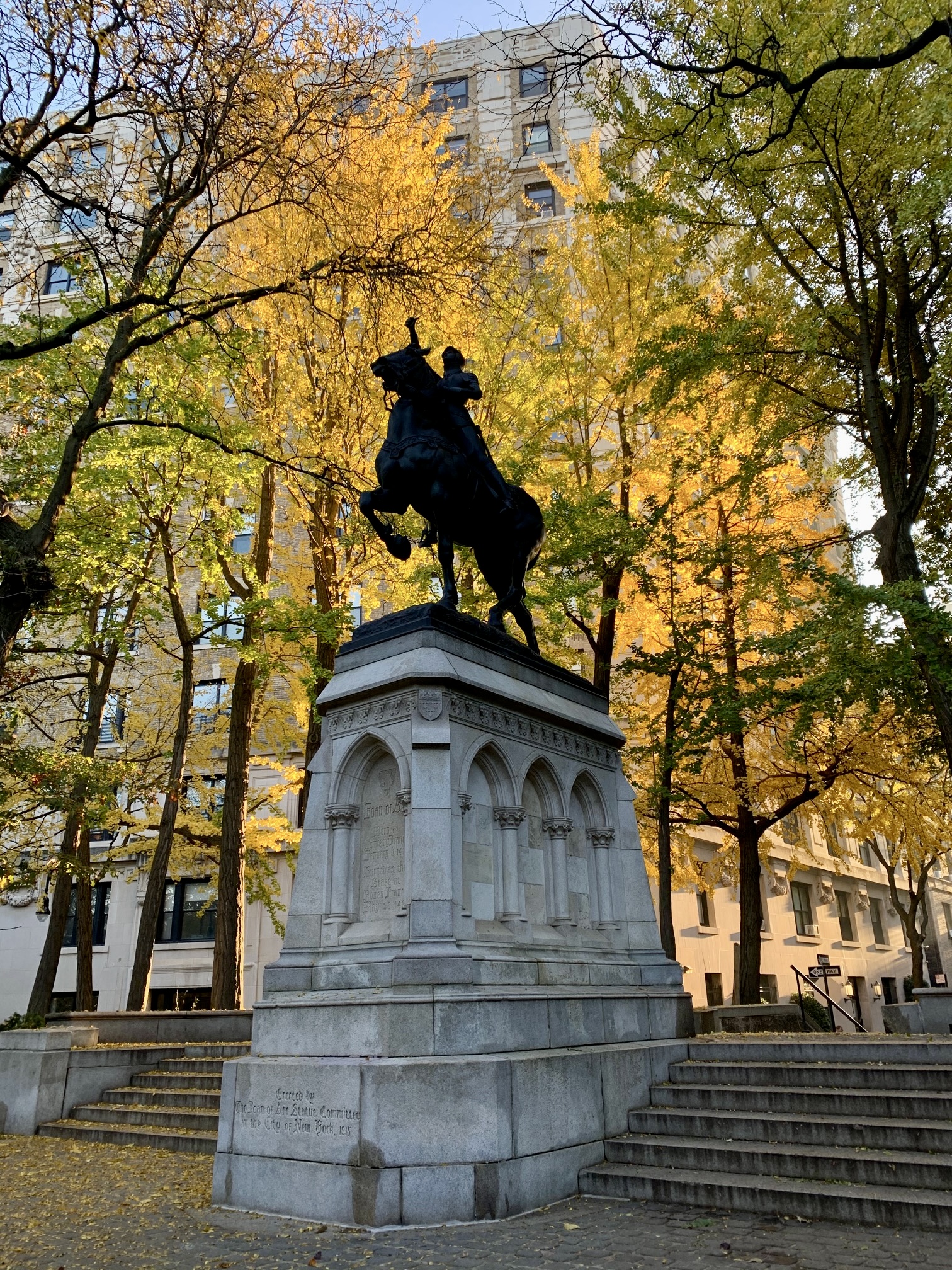
Joan of Arc lived from 1411-1431. Known as Jeanne La Pucelle when she lived with her peasant family in northeastern France, she believed it was her divine mission to free the French from English rule. She convinced the Dauphin of France to give her command of a small army, which she used to make the English withdraw in 1429. Her victory enabled the Dauphin to be crowned as King Charles VII in Reims Cathedral. Captured by the Burgundians in 1430, Joan of Arc was sold to the English who accused her of witchcraft and heresy. She was found guilty in a religious trial and in 1431, was burned at the stake. Her sentence was annulled twenty years later and 500 years after, she was canonized as Saint Joan.
In 1909, two years before the 500th anniversary of Joan of Arc’s birth, a group of prominent New York City citizens formed a committee to erect a monument in her honor. Coincidentally, a young sculptor, Anna Hyatt Huntington, was living in France and became interested in the story of Joan of Arc. She created a life-sized plaster equestrian statue of Joan of Arc, in which she chose to emphasize “the spiritual rather than the warlike point of view” by showing Saint Joan standing up in her stirrups with her sword and her gaze lifted upwards towards Heaven. Huntington submitted the statue to the prestigious Salon de Paris where it received “an honorable mention from the jury, despite skepticism that such an accomplished work of art could have been made solely by a woman.” Huntington’s design impressed the New York committee however, and they gave her the monument commission.
Despite its heroic scale, the statue is quite realistic. Huntington researched Joan of Arc’s armor at the Metropolitan Museum of Art, and she modeled the horse after one that she borrowed from the fire department in her hometown of Gloucester, MA. The sculptor used her niece, posed riding a barrel, as the model for the mounted figure.
The Joan of Arc monument was dedicated in 1915, in an elaborate ceremony with Mrs. Thomas Edison pulling the sheet off the statue. With most of Europe at war, people saw the statue as a symbol of solidarity between the US and France. The pedestal is made of New York State Mohegan granite and is decorated with Gothic style blind arches and coats of arms. It contains several blocks of limestone from the tower in Rouen where Joan of Arc was imprisoned before her death.
The Joan of Arc monument was the first public statue in New York of an actual (non-fictional) woman. According to the NYC Parks Department, New York has 125 statues honoring historical figures and today, there are only six other public statues of real women in NYC: Israeli Prime Minister Golda Meir (1984, Broadway and 39th Street), novelist Gertrude Stein (1992, Bryant Park), First Lady Eleanor Roosevelt (1996, Riverside Park), abolitionist Harriet Tubman (2008, Saint Nicholas Ave and West 122nd Street), Women’s Rights Pioneers Monument – Sojourner Truth, Susan B. Anthony and Elizabeth Cady Stanton (Aug 2020, Central Park), and Mother Cabrini, founder of hospitals and schools (Oct 2020, Battery Park).
Thanks to She Built NYC, a public-arts campaign that honors “pioneering women by installing monuments that celebrate their extraordinary contributions to the city and beyond,” six more monuments are planned: Congresswoman Shirley Chisholm in Prospect Park, jazz singer Billie Holiday (Queens, near Borough Hall), anti-segregation activist Elizabeth Jennings Graham (near Grand Central Terminal), lighthouse keeper Katherine Walker (Staten Island), public health pioneer Dr. Helen Rodriguez Trias (the Bronx), and transgender rights activists Marsha P. Johnson and Sylvia Rivera (Greenwich Village).
The Woman’s Health Protective Association Monument
West 116th Street

Located at the entrance to Riverside Park at 116th Street, this is one of the oldest monuments in the park. In 1909, six years before the Joan of Arc Monument was unveiled, the New York City chapter of the Women’s Health Protective Association (WHPA) commissioned this monument to commemorate the 25th anniversary of their founding in 1884. The WHPA was a group of well-connected women who organized and eventually had a big impact in improving the New York City’s health conditions. The WHPA’s first targets were rotting “manure grounds” and slaughterhouses located along First Avenue between 43rd and 47th Streets. WHPA members staged protests, attracted press coverage, and took the offending business owners to court for maintaining public nuisances. They then tackled the toxic fumes emitted by large gas storage tanks on the Lower East Side, the filthy condition of the city streets, the city’s impure water supply and sewer system, school hygiene and free lunches, spitting in public, food safety, garbage disposal, and sanitation of immigrant ships, prisons and tenements. They lobbied the New York City Metropolitan Board of Health as well as city and state legislatures, who eventually passed some of the city’s first sanitary laws.
The Women’s Health Protective Association monument, which consists of a carved marble stele and working drinking fountain, was designed by sculptor Bruno Louis Zimm and dedicated in 1910. The eleven-foot stele is made of Knoxville, TN marble and depicts two female figures holding a lamp, meant to represent the Association’s commitment to shedding light on New York City’s public health issues. The fountain itself symbolizes the group’s eventual success in getting the city to purify NYC’s Croton water supply. Association members’ names are inscribed on benches on both sides of the stele, including Charlotte Wilbour, who helped found the first New York City Woman Suffrage Association in 1870.
Eleanor Roosevelt Statue
West 72nd Street
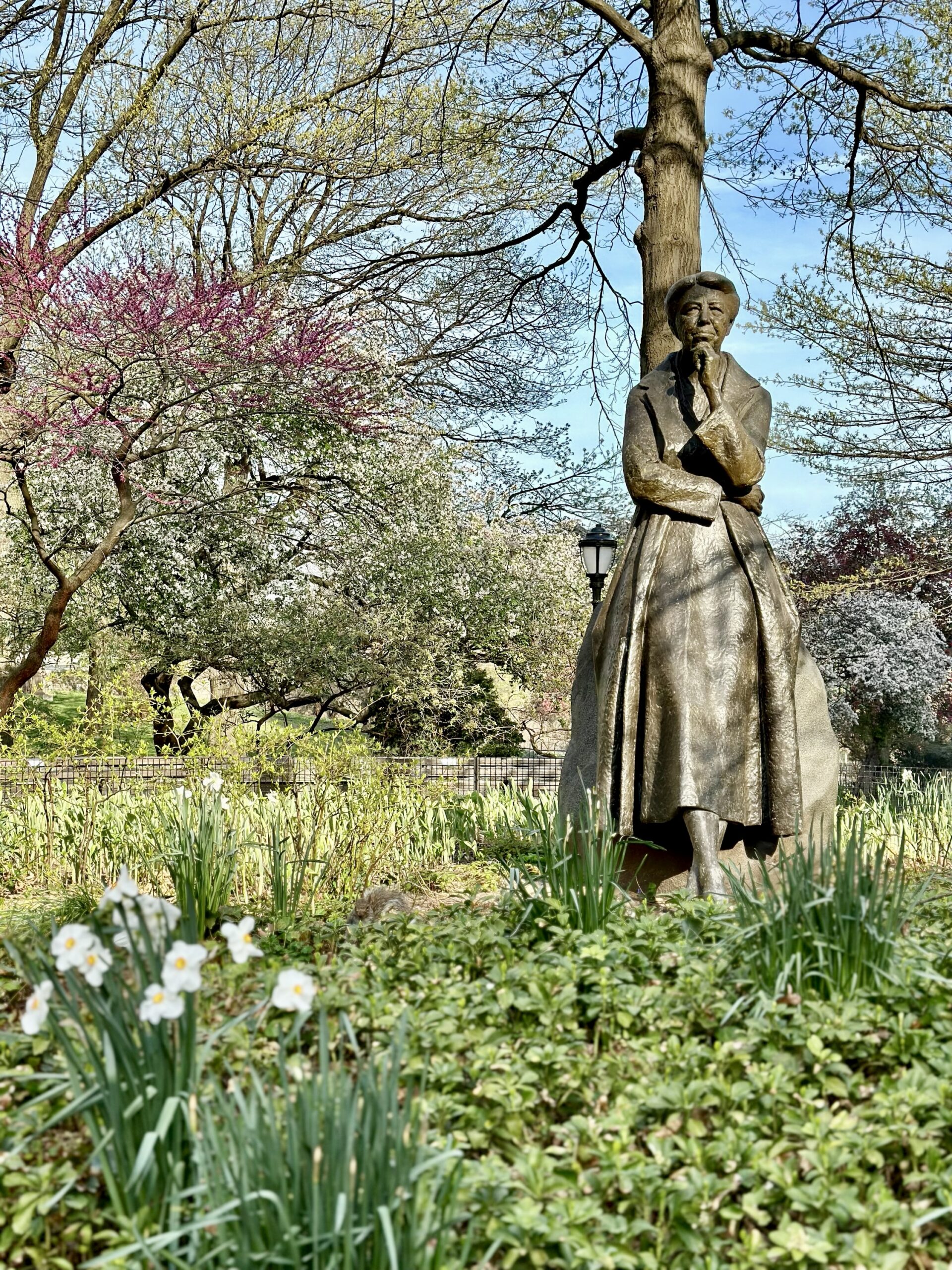
Eleanor Roosevelt lived from 1884 to 1962. She first became involved in humanitarian causes at the age of 18, when she worked as a volunteer teacher at a settlement house on the Lower East Side. A niece of President Teddy Roosevelt, she married her distant cousin and the future American president, Franklin Delano Roosevelt. Eleanor Roosevelt dedicated her life to serving others, advocating for the disadvantaged, and playing an active role in organizations such the American Red Cross, the League of Women Voters and the Women’s Trade Union League. As First Lady and during the years afterwards, she fought racial inequality, poverty and unemployment. While touring the South to speak against segregation and lynching, the FBI told her that the Ku Klux Klan had promised a $25,000 reward for her assassination. Throughout her life she received death threats so she often carried a handgun for protection. After her time as First Lady, she served as the US Representative to the United Nations for seven years.
The Eleanor Roosevelt statue is only the second public statue dedicated to a woman in a NYC park, a staggering 80 years after the first (Joan of Arc) – and it’s also in Riverside Park. Artist Penelope Jencks won the national competition to design the statue in heroic scale – the statue is close to 8 feet tall – and I remember it being dedicated by then First Lady Hillary Clinton on October 5, 1996. The statue, made of bronze and stone, is meant to be informal and contemplative. Jenks used Phoebe Roosevelt, Eleanor’s great-granddaughter, as the model for the torso because her bearing resembled that of the First Lady. Quotations by Mrs. Roosevelt and Adlai Stevenson are inscribed in stone panels in the walkway around the statue.
Ralph Ellison Memorial
West 150th Street
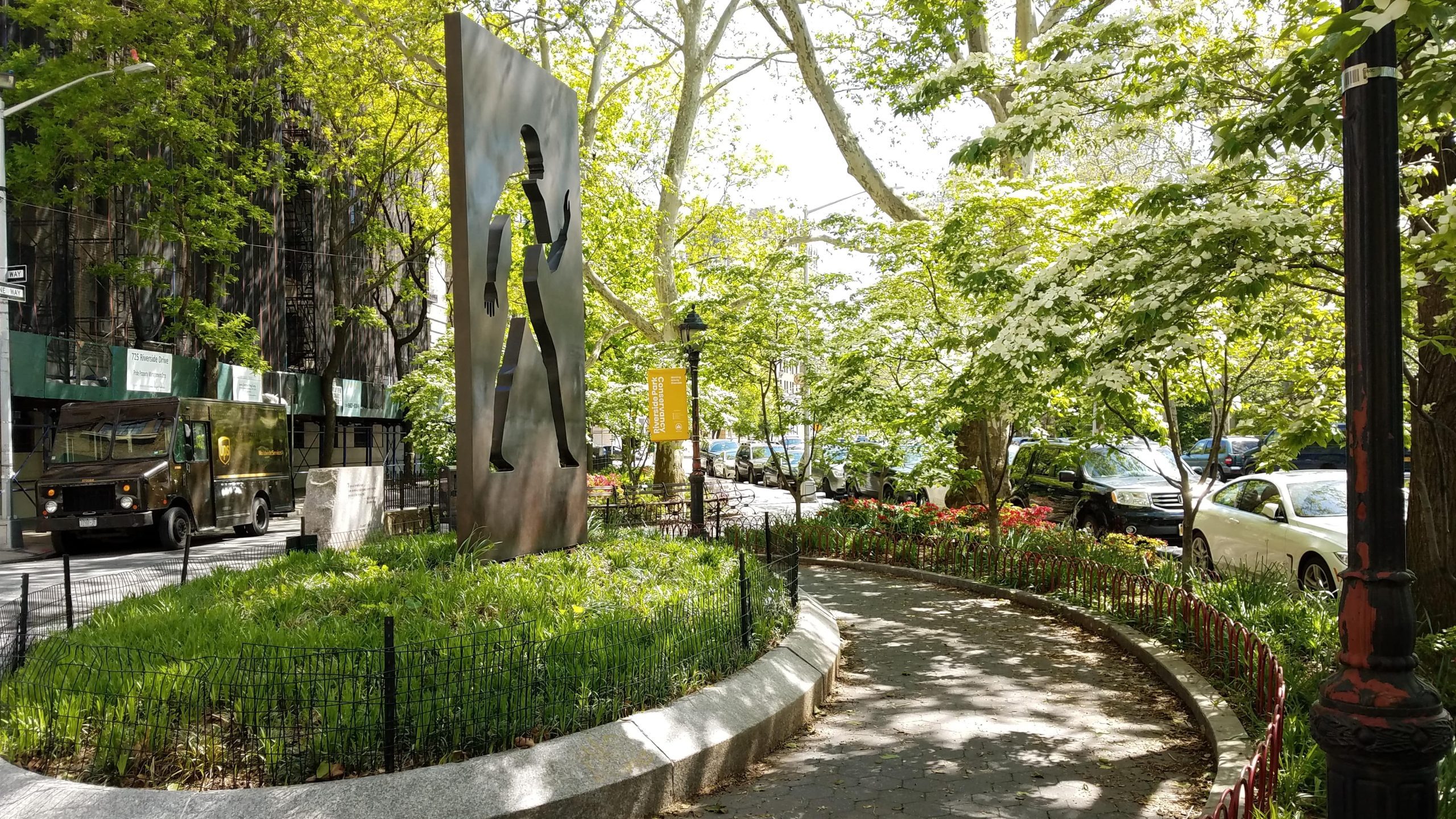
While the Ralph Ellison memorial was not erected in honor of a woman, it was designed by a notable female artist, Elizabeth Catlett.
Ralph Waldo Ellison was born in Oklahoma City in 1914 and moved to New York in 1936 as part of the Federal Writers’ Project. He was an American writer, literary critic, scholar and teacher. Ellison’s first novel Invisible Man (1952) brought him literary stature, international fame and a National Book Award. He lived a block away from the location of the memorial at 730 Riverside Drive and is buried in the nearby Trinity Cemetery.
The Ralph Ellison Memorial, located on the east side of Riverside Drive at 150th Street, was created as a joint project by the Riverside Park Fund (now Riverside Park Conservancy) and the Ralph Ellison Memorial Committee, a neighborhood group some of whose members knew Ellison personally. Dedicated in 2003, the sculpture was funded through private donations and the surrounding landscaping was City-funded.
Elizabeth Catlett’s 15-foot bronze sculpture, Invisible Man, is the heart of the memorial to Ellison. The monument also features three Deer Isle granite panels inscribed with quotes by Ellison and his biography. Catlett was selected through an art competition held by the Riverside Park Fund and the Ralph Ellison Memorial Committee. Invisible Man is Catlett’s only public commission in New York. The monument’s central image is a bronze rectangular panel with a cutout of an assertive man in motion. Catlett’s sculpture reflects the themes of Ellison’s novel, which deals with “issues of racial identity, alienation and assimilation.” Catlett’s own experience as a Black woman during the era of segregation had a profound effect on her life’s work.
Special thanks to the NYC Parks Department and Tom Miller, author of the Daytonian in Manhattan blog, for much of the source material for this post.
About Riverside Park Conservancy
From 59th Street to 181st Street, from riverfront to city-side, Riverside Park Conservancy cares for and enhances six miles of parkland for present and future generations. Working together with NYC Parks, we make improvements as diverse as the park itself and the city it serves.


